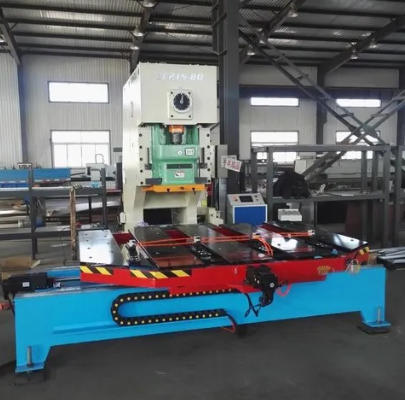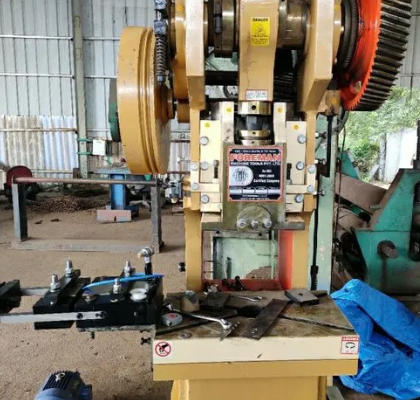Views: 222 Author: Rebecca Publish Time: 2025-11-03 Origin: Site









Content Menu
● Understanding the Automatic Feeder System
● The Evolution of Feeder Technology
● Enhanced Efficiency: Speed and Throughput
● Achieving Unmatched Consistency and Quality
● Labor Optimization and Workplace Safety
● Flexibility for Customization and Product Variety
● Minimizing Waste and Optimizing Processes
● Technical Deep Dive: Servo and Robotic Feeders
● Environmental and Sustainability Benefits
● Case Studies: Real-World Results
● Successful Implementation Roadmap
● FAQ
>> 1. How does an automatic feeder improve kitchenware quality?
>> 2. Can automatic feeders handle different kitchenware sizes and shapes?
>> 3. What labor savings can be expected from automation?
>> 4. How is maintenance managed for these systems?
>> 5. Are there environmental benefits to using automatic feeder systems?
In today's fiercely competitive kitchenware industry, achieving consistent product quality, reducing costs, and responding quickly to evolving consumer demands are critical for success. Automatic feeder systems have emerged as strategic assets, delivering materials and components to production lines with unparalleled precision and reliability. As factories pursue smarter manufacturing strategies, feeder automation is redefining what is possible in terms of productivity, quality assurance, and operational agility.

Automatic feeder systems are machines designed to supply, orient, and deliver metal blanks, small components, or subassemblies directly to presses, machines, or assembly points—often without human touch. Common types in kitchenware manufacturing include:
- Vibratory Bowl Feeders for bulk alignment and orientation of utensils or small parts.
- Belt and Conveyor Feeders for continuous transfer in assembly or packaging stages.
- NC Servo Feeders for micron-level accuracy, essential in stainless steel pot lid stamping.
- Robotic or Flexible Feeders that integrate machine vision for sorting and quality inspection.
These systems combine sensors, digital controls, programmable interfaces, and sometimes robotics, making them an essential part of modern production lines. Their modular architecture ensures seamless integration with other factory automation solutions.
Improvements in feeder design reflect greater demands for:
- Programmability: Modern feeders can be reprogrammed in minutes for different parts, materials, or production speeds.
- Sensor Integration: Built-in sensors track the position, orientation, and quality of each part, minimizing errors and supporting real-time analytics.
- Connectivity: Feeders now “talk” to upstream and downstream systems, enabling coordinated action and end-to-end traceability.
- Smart Factories: In leading facilities, feeders contribute to the larger “smart factory” vision—where every machine is linked, adaptive, and self-optimizing.
Efficiency in kitchenware manufacturing directly translates to profitability. Automatic feeder systems enable:
- Increased Throughput: Automated feeders can process thousands of items per hour, far surpassing manual handling capacity.
- Continuous Operation: Factories benefit from near 24/7 uptime, with minimal breaks or slowdowns due to material handling delays.
- Reduced Downtime: Intelligent feeders minimize jams and mis-feeds, keeping production lines moving and reducing costly interruptions.
- Optimized Cycle Times: With materials delivered exactly when needed, every piece of equipment operates at peak efficiency.
This operational transformation empowers scale—allowing both global brands and agile startups to meet ambitious targets with fewer resources.
Uniform product quality is a key differentiator in kitchenware. Still, manual feeding is prone to inconsistency, leading to defects, rework, and dissatisfied customers. Automation solves these challenges by:
- Standardized Delivery: Every component is positioned identically on every cycle, eliminating variations caused by fatigue or inattention.
- Advanced Inspection: Integration with vision systems allows feeders to detect and remove flawed parts before they reach critical processing stages.
- Surface Protection: Gentle yet precise handling preserves the mirror finish of steel, aluminum, or ceramic kitchenware, supporting premium product lines.
- Shrinkage of Defect Rates: Plants deploying feeder automation report defect rates dropping below 2%, supporting even the most stringent quality protocols.

Manual material feeding is repetitive, physically demanding, and sometimes hazardous—especially with moving machinery or sharp-edged metal parts. Automatic feeders replace hours of fatigue-prone work with:
- Labor Savings: Factories can reallocate personnel from manual tasks to more technical, value-added roles in programming, QA, or equipment maintenance.
- Safer Environments: With fewer people exposed to dangerous processes, workplace injuries decline, and compliance with safety standards is easier to maintain.
- Multi-line Oversight: One operator can monitor several automated lines, rather than being dedicated to a single feeding point.
These improvements elevate staff engagement and morale, turning factories into more attractive workplaces.
The market rewards brands that deliver variety and customization. Automatic feeder solutions provide vital flexibility by:
- Rapid Changeovers: Tool-free adjustments allow fast switching between product styles, sizes, or materials.
- Support for Small Batches: Automation lowers the cost of short runs and limited-edition lines, meeting trends as they emerge.
- Digital Inventory and Batch Control: Each production change is instantly logged for traceability, while feeder settings ensure perfect transition.
- Batch Size Optimization: Factories can efficiently handle both large industrial orders and small “just-in-time” shipments.
With these capabilities, manufacturers stay adaptable and customer-focused.
Waste in manufacturing doesn't just mean lost material—it affects profits, environmental impact, and customer trust. Automatic feeder systems boldly address these concerns:
- Reduced Scrap Rates: Precise orientation and delivery prevent product damage, jams, and incorrect assembly.
- Die and Tool Protection: Consistent loading reduces premature wear on expensive dies and other high-value tooling, extending their operational lifespan.
- Early Fault Detection: Smart feeders with inspection cameras or sensors spot and reject off-spec parts immediately.
- Continuous Data Analysis: Feeder systems capture production data, supporting lean manufacturing, OEE (overall equipment effectiveness) optimization, and sustainable practices.
Such process control is central to achieving both high yields and environmental stewardship.
Let's look at developments that drive kitchenware innovation:
- NC Servo Feeders: These digitally-controlled feeders deliver stamped metal with pinpoint accuracy. Speeds and lengths can be rapidly changed, making them perfect for complex shape forming or thin-walled kitchenware.
- Robotic Feeders: Combining the best of traditional feeders with the flexibility of robotics, these systems handle even fragile, varied, or irregular-shaped components, and easily integrate with downstream robotic assembly or finishing.
- Modular Designs: Allow quick upgrades as production needs change, ensuring future-proof investment and continuous competitiveness.
Today's consumers and regulators expect manufacturers to address their environmental impact. Feeder automation contributes:
- Less Scrap: With more precise feeding and immediate rejection of bad components, less material is wasted.
- Lower Energy Use: Efficient feeding aligns with optimized cycle times and machine loads, using less power.
- Longer Equipment Life: Gentle, timely part delivery reduces wear and means fewer costly repairs.
- Sustainability Metrics: Factories can report on progress toward energy-saving and waste-reduction goals.
Such advances are not only good for the planet—they are increasingly vital for reputation and brand loyalty.
Across the globe, kitchenware manufacturers integrating automatic feeder systems have reported:
- Productivity Boosts: Companies see production increases of 30–40% after adopting feeder automation.
- Quality Improvements: Defect rates often drop below 2%, enabling compliance with even the strictest international standards.
- Labor Cost Reductions: Some medium-sized plants save hundreds of thousands of dollars in payroll annually.
- Order Fulfillment: Enhanced ability to ship custom or limited-edition products with shortened lead times.
These outcomes underscore why automation has become a strategic pillar for successful kitchenware brands.
For manufacturers considering automation, best practices include:
- Audit Processes: Identify current bottlenecks and quantify benefits possible from feeder automation.
- Feeder Selection: Match feeder type to product, batch size, and upgradeability needs.
- Seamless Integration: Connect feeders to ERP, MES, or QC systems for end-to-end digital oversight.
- Ongoing Training: Develop personnel skills to program, maintain, and optimize automated lines.
- KPI Monitoring: Regularly evaluate efficiency, defect rates, and downtime; use these metrics for continuous improvement.
This strategic approach ensures that automation delivers on its promise of value and future-readiness.
Automation does not simply replace jobs; it transforms them, elevating careers and job satisfaction. With automatic feeder systems, roles evolve:
- Upskilling: Employees learn to manage, program, and troubleshoot advanced technology.
- Job Enrichment: Positions become more technical, focusing on optimization, maintenance, and process improvement.
- Collaborative Success: Human and machine work together in a balanced ecosystem, creating more productive and sustainably-run factories.
By investing in people and technology together, manufacturers build resilient, forward-thinking operations.
Automatic feeder systems have revolutionized kitchenware manufacturing, establishing new benchmarks for quality, speed, flexibility, and cost control. Their implementation enables consistent, flawless product delivery, minimizes waste, and advances both environmental and workforce sustainability. The magnitude of efficiency and precision achievable with automatic feeding technology ensures that manufacturers can not only meet but exceed the dynamic demands of the global market. For any kitchenware company aiming for operational excellence, investing in automatic feeder systems is a decisive competitive advantage.

Automatic feeders standardize part delivery and orientation, essentially removing the risk of human error and ensuring products meet exact specification—enhancing both appearance and structural integrity.
Absolutely. Modern systems are designed with modularity and programmable logic, allowing easy changeovers for diverse product dimensions and designs.
Automatic feeders can reduce the number of required line operators by up to half, enabling manufacturers to reassign workers to higher-value technical or supervisory tasks and creating a safer workplace.
With modular design and predictive maintenance tools, upkeep is straightforward—diagnostics and routine service can be performed quickly, minimizing downtime.
Yes. By decreasing scrap and energy usage while extending equipment longevity, automation directly supports sustainability goals and reduces the factory's environmental footprint.
Is Your Production Line Ready for An Automatic Feeder System? Find Out Here
What Makes The Automatic Feeder System A Must-Have in Modern Manufacturing?
How An Automatic Feeder System Boosts Precision in Kitchenware Manufacturing?
Automatic Feeder System Buying Guide: Key Considerations for Your Production Needs
The Advantages of Integrating An Automatic Feeder System with Your Existing Machinery
Why Top Manufacturers Choose Automatic Feeder Systems for Their Production Lines?
What To Look for in A High-Quality Automatic Feeder System for Kitchenware Production?
The Future of Cutlery Manufacturing: Why You Need An Automatic Feeder System?
Automatic Feeder System Vs. Traditional Feeding Systems: Which Is Better for Your Factory?
Comparing The Best Automatic Feeder Systems: Features And Benefits
